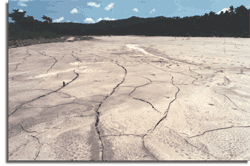PRESSURE FOM THE U.N.
An investigative team from the United Nations visited the island shortly after the tailings spill and noted:
"…it is unclear why an environmental impact assessment of the Tapian Pit option was never carried out; why no apparent efforts had been made to find an alternative disposal method and site…why no monitoring of the portal area was being carried out even though it was reported to the U.N. Mission that the mine tailings had been escaping in some quantity for a considerable period of time…
The unconventional use of the Tapian Pit as a containment system for tailings, particularly because of the presence of a disused drainage tunnel near its bottom, should have been sufficient to ensure that risk assessment and contingency planning were carried out. Furthermore, it is clear from cross-sectional diagrams of the drainage tunnel that were reviewed at the mine site that fracture zones and ground water seepage were likely to occur along its length."
The UN team noticed unrelated leaks in other mine structures and concluded, "it is evident that environmental management was not a high priority for Marcopper."Read
With that black-eye from the United Nations, Placer Dome had to attempt to rebuild its reputation and show that it was concerned, that it had corporate social responsibility. The people and the world at large had to be appeased. "Since we take our responsibility of good corporate citizenship very seriously I feel that Placer Dome also has a larger moral responsibility...", John Wilson, president and CEO eventually wrote in a letter to President Fidel V. Ramos. The letter expressed the company's concerns and commitments (see below) to the people, health and environment.
A stipulation in the proposed settlement agreement now refers to this same letter thus:
"(xiv) following the March 24, 1996, Marcopper Mine tailings spill (the "1996 tailings spill"), PDI made voluntary commitments to the then-President of the Philippines, Fidel V. Ramos, to ensure that Marcopper had the technical and financial resources available to mitigate the effects of the tailings spill and to compensate those who had been adversely impacted by the tailings spill. PDI did so on a purely voluntary basis and without admitting or accepting any legal liability for the 1996 tailings spill or otherwise in connection with Marcopper's mining activities;
"(xv) these voluntary commitments of PDI did not give rise to obligations with any legal force and, in any event, they were fully satisfied;"
* * *
Excerpt from the Letter to Pres. Fidel V. Ramos by John M. Wilson, President and CEO, Placer Dome, Inc., April 11, 1996:"Concerns for Health
"We are firmly convinced that the material which escaped into the river system is not toxic to human health. Nevertheless, Marcopper will continue to monitor the health of residents affected by the accident as well as their sources of drinking water.
In addition, we understand an independent third party may be requested to conduct an independent assessment of the effects of the accident. Placer Dome has agreed to pay for this assessment.
"Concerns for Environment
"Once the flow of tailings from the mine has been stopped, the task of environmental rehabilitation, both near an long term, must begin. Marcopper, as well as Placer Dome, recognizes its responsibility to rehabilitate all areas impacted by the tailings flow and is committed to a program which will result in the mitigation of the environmental impact. This program will include:
1. rehabilitation of the river system;
2. the remediation of off-river impacts;
3. the provision of improved road access to villages;
4. the implementation of improved flood protection measures;
5. the implementation of health and environmental monitoring programs; and
6. the development and undertaking of a program of river and ocean rehabilitation.
"To ensure that funding for the environmental rehabilitation program is available, a Marcopper Rehabilitation Fund will be established by Marcopper with an initial contribution from Placer Dome."
Klohn Crippen commissioned by Placer Dome reported to the company on June 14, 2001 that five dams and structures were unstable and two posed an immediate threat to human life. Placer Dome did not act on this information. On October 11, 2001 the Philippine Government ordered Placer Dome to begin to fix the faulty dams and structures. Instead, Placer Dome left the country.
Placer Dome left the Philippines in December 2001 without fulfilling commitments made to the Office of the President following the tailings disaster in 1996, and in disregard of a government order of October 2001 to fix dams and structures whose collapse threatens another ecological disaster and loss of human life in Marinduque. Read
As Placer Dome had disappeared from the scene, an 18-month Marinduque Environmental and Health Study (MEHS) was undertaken by US scientists in 2003. The US team consisted of scientists from three different US organizations - the US Geological Survey (USGS), led by Dr. Jack Medlin; the Armed Forces Institute of Pathology Scientists, led by Dr. Jose Centeno; and the University of Arizona, led by Dr. Hugh Miller and James Madson.
The P20-million study was funded by President Arroyo's Social Fund. Half of the fund was turned over to the Marinduque provincial government according to DENR. According to Environment Secretary Elisea Gozun the MEHS would include a comprehensive mine environmental and health assessment, evaluation of the final remediation options, and preparation of a monitoring program for the Boac and Mogpog rivers, the Marcopper mining site and the Calancan Bay. Read
That's what happened.
 |
| Earlier Boac River photo, PCIJ |

